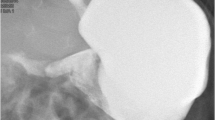Abstract
Gastric volvulus was first described by Berti in 1966. Whereas acute gastric volvulus is very rare, chronic gastric volvulus on the other hand is being diagnosed with increasing frequency. This is attributed to the liberal use of barium meal for the evaluation of infants and children with repeated attacks of vomiting and recurrent chest infection. This report describes our experience in the management of 36 infants and children with acute and chronic gastric volvulus. Their medical records were retrospectively reviewed for: age at diagnosis, sex, symptomatology, diagnosis, treatment and outcome. There were 22 males and 14 females. Their ages at presentation ranged from 1 week to 2.5 years (mean 6.7 months). Their symptomatology included repeated attacks of vomiting (30 patients), recurrent chest infection and asthma like symptoms (6 patients), failure to thrive (6 patients), chocking with feeds (3 patients), loose bowel motion (3 patients) and apnoea attack (1 patient). Two presented acutely with intrathoracic gastric volvulus. One of them had recurrent left diaphragmatic hernia while the other had a large paraesophageal hernia. The remaining patients had chronic intraabdominal gastric volvulus. Radiologically, all had organo-axial gastric volvulus except one who had mesenterico-axial gastric volvulus and 33 (97%) of them had demonstrable gastroesophageal reflux. Eleven were treated conservatively because their symptoms were mild to moderate and settled. The two patients with intrathoracic gastric volvulus underwent reduction of the contents, repair of the defect and anterior gastropexy. The remaining patients underwent gastropexy, both fundal and anterior. Intraoperatively, two were found to have diaphragmatic hernia, nine had mobile (non-fixed) spleen, and eight showed mobile stomach with lax ligaments. Post-operatively, all did well and showed good improvement with disappearance of their symptoms and increase in weight. Acute gastric volvulus is very rare. Prompt clinical suspicion and radiological assessment are essential to treat this life-threatening condition. Chronic gastric volvulus on the other hand is more common but under diagnosed. It should be included in the differential diagnosis of infants and children with repeated attacks of chest infection, vomiting and failure to thrive. Barium meal should form part of their investigations. The treatment of chronic gastric volvulus depends on their symptomatology. Those with mild to moderate symptoms should be treated conservatively, while those with persistent and severe symptoms should undergo anterior (to the abdominal wall) and fundal (to the diaphragm) gastropexy without fundoplication.




Similar content being viewed by others
References
Samuel M, Burge DM, Griffiths DM (1995) Gastric volvulus and associated gastroesophageal reflux. Arch Dis Child 73:462–464
McCallion WA, Potts SR, Wallace EC (1992) Chronic organoaxial malrotation of the stomach in childhood. Eur J Pediatr Surg 2:365–367
Del Rossi C, Cerasoli G, Tosi C et al (1993) Intrathoracic gastric volvulus in an infant. Pediatr Surg Int 8:146–148
Chattopadhyay A, Vepakomma D, Prakash B, Kumar V (2005) Is gastropexy required for all cases of gastric volvulus in children? Int Surg 90:151–145
Al-Salem AH (2000) Intrathoracic gastric volvulus in infancy. Pediatr Radiol 30:842–845
Nakada K, Kawaguchil F, Wakisaka M et al (1997) Digestive tract disorders associated with asplenia/polysplenia syndrome. J Pediatr Surg 32:91–94
Borchardt M (1904) Zur pathologie und therapie des magenvolvulus. Arch Klin Chir 74:243–250
Honna T, Kamii Y, Tsuchida Y (1990) Idiopathic gastric volvulus in infancy and childhood. J Pediatr Surg 25:707–710
Elhalaby EA, Mashaly EM (2001) Infants with radiological diagnosis of gastric volvulus: are they over-treated? Pediatr Surg Int 17:596–600
Author information
Authors and Affiliations
Corresponding author
Rights and permissions
About this article
Cite this article
Al-Salem, A.H. Acute and chronic gastric volvulus in infants and children: who should be treated surgically?. Pediatr Surg Int 23, 1095–1099 (2007). https://doi.org/10.1007/s00383-007-2010-y
Accepted:
Published:
Issue Date:
DOI: https://doi.org/10.1007/s00383-007-2010-y




